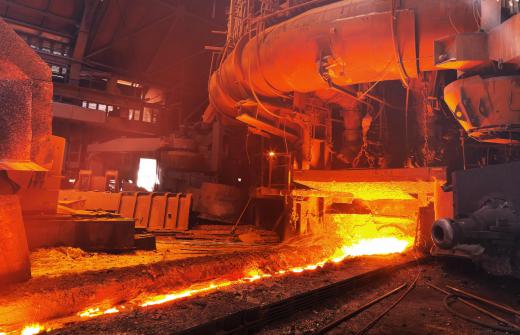At AboutMechanics, we're committed to delivering accurate, trustworthy information. Our expert-authored content is rigorously fact-checked and sourced from credible authorities. Discover how we uphold the highest standards in providing you with reliable knowledge.
What is Metal Casting?
Metal casting is a metalworking technique in which molten metal is poured into a mold and allowed to set before being removed to reveal a metal piece which can be finished with grinding, sanding, and polishing before being sold. This is one of the oldest metalworking techniques in the world, with evidence of cast metal pieces being found at archaeological sites all over the world, sometimes demonstrating a very high level of skill. This technique continues to be utilized today in a broad range of industries.
A wide variety of materials can be used to make molds for metal casting, depending on the metal being worked. The material needs to be strong and durable enough to withstand the hot metal, while being workable enough to be to be carved or worked into a mold. Wood, limestone, plaster of Paris, and ceramic have all been used for molds, and crude metal casting has been performed by pouring molten metal into forms made by hollowing out sand or clay. Re-usable molds for metal casting click together, holding the metal while it sets and then pulling apart.

Some molds are made by carving a form from wax, including a high level of detail so that the piece will be as finished as possible. The wax can be inserted into a wet ceramic or plaster of Paris block and then fired, leaving the shape of the mold behind while the wax flows out. This technique is known as “lost wax casting,” and it is simple enough to be taught in elementary school art classes.

To do metal casting, people usually need access to a foundry, a facility which has been specially outfitted for work with hot metals. Foundries include a very hot furnace or fireplace known as a forge which can be used to work metal directly for blacksmithing, or to melt metals for metal casting. Once metal is molten, it can also be alloyed with other metals to bring out desired properties, and then carefully poured into molds for casting.
Different metals require unique levels of skill to work with, as indicated by the terms “Bronze Age,” “Iron Age,” and so forth for different periods in human history. Some foundries are equipped to handle a range of metals, including metals which need a very high temperature for working, while others are more crude, and designed to be used with softer metals which are easier to work. Metal casting can also be accomplished with fine metals like silver and gold to make cast jewelry.
AS FEATURED ON:
AS FEATURED ON:












Discussion Comments
@Iluviaporos - The lost wax method is just as viable as using clay, as the wax can be shaped just as easily. Even better, if you know what you're doing, you can make a mold that will last for more than one casting, rather than always creating a one-off piece.
There's a gorgeous bronze statue on the waterfront of the city where I live of a man leaning into the wind. The artist deliberately didn't seal the metal so that the sea air would help to shape the sculpture, which is quite romantic, but in a way I think it's a mistake since the statue is so lovely, it would be a shame for future generations to miss out on it.
@clintflint - Well, there are other ways of working with metal these days that don't necessarily need a full metal casting process.
Something I enjoy working with is silver metal clay. It requires a completely different approach and takes a while to get used to (particularly since it shrinks from the original design so you have to compensate for that) but I find it has a lot more versatility when it comes to smaller designs than metal casting.
On the other hand, you do still need a kiln in order to set it properly, which for some people might be just as difficult to find as a foundry, so it's up to the individual really.
I did an art course a few years ago which was generally a bit of a waste of money, except that they had their own foundry attached to the school. There aren't many places around where you can really experiment with metal casting and they took us through several different methods step by step, including bronze sculpture and the lost wax method.
Of course, we needed to buy our own metals which could be expensive, but a few people even managed to make gold and silver jewelry. If you've got any interest in that kind of thing, I would definitely recommend looking online for a school that has a metal casting foundry as you won't be able to get the full experience anywhere else.
Post your comments